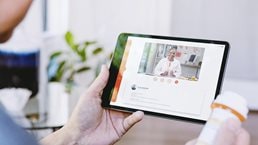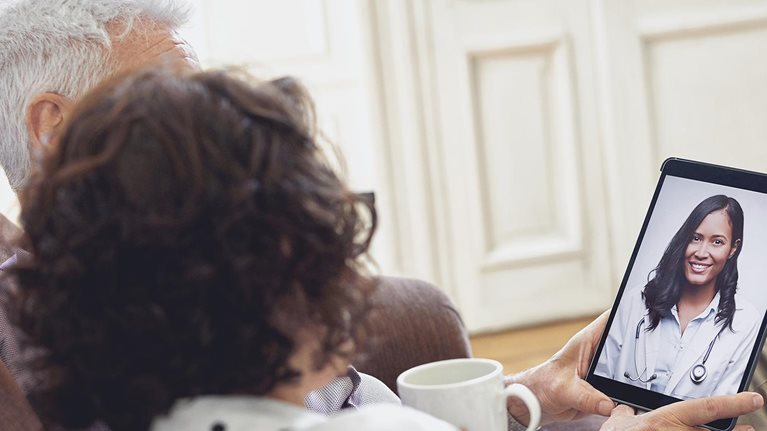In recent years, sleep loss has become a critical issue, with far-reaching implications for human health and well-being. One in three Americans does not get enough sleep; globally, up to 45 percent of the population doesn’t.1 In the past few years, the rise of smart watches, fitness trackers, and other consumer wearables has made it possible to monitor sleep remotely at scale. The information from these devices is yielding insights that can be used to better understand sleep and find ways to counter sleep loss. Sleep tech is now a growing industry that is drawing new entrants, from start-ups to big tech companies, and attracting the interest of insurance companies, healthcare organizations, employers, and policy makers.
The costs of sleep loss
Sleep loss—particularly the loss of deep (or slow-wave) sleep—is linked to a long list of chronic health conditions, including Alzheimer’s disease, anxiety, dementia, depression, hypertension, and type 2 diabetes.2 It also affects cognitive function, attention, and decision making.3
In addition to this detrimental effect on health, sleep deprivation carries high economic costs, estimated at $680 billion a year in five OECD countries—for example, $400 billion for the United States and $60 billion for Germany.4 Similarly, a study calculated that the direct and indirect cost of sleep disorders in Australia equals 1 percent of GDP.5
Sleep-related absence from work is thought to account for the loss of ten million working hours a year in the United States, 4.8 million in Japan, and 1.7 million in Germany. Lost sleep also takes a toll on productivity: an analysis using data from US companies puts the annual cost at $1,300 to $3,000 per employee.6 And lost sleep not only impairs the performance of employees at work but also raises healthcare costs for employers.7
Countering sleep loss
According to sleep researchers and physicians, people can improve their own sleep by setting consistent sleeping and waking times, increasing early-morning exercise, reducing alcohol and caffeine consumption, and eliminating blue-light exposure from screens for at least an hour before going to bed. For employers, the recommendations include recognizing the importance of sleep to health and performance in the workplace, providing access to amenities such as napping booths and gyms, and discouraging after-hours work.

Technological solutions, such as consumer wearables, have also increasingly addressed the global decline in sleep levels. In the United States, the number of sleep-technology patents has increased by an average of 12 percent a year over the past decade. Market forecasts indicate that the resulting influx of sleep devices could take the global market to some $32 billion by 2026, up from $11 billion in 2019.8 Many of the new devices focus on monitoring the quality of sleep, motion, and bio-signals (Exhibit 1) and therefore open up the possibility of accurately monitoring sleep at scale for the first time.9
Sleep technology: Perspectives from academia
Research has shown that consumer wearables can be used to investigate the relation of sleep to demographic, socioeconomic, and lifestyle factors and to various markers of health and aging.10 As wearables become increasingly common, remote monitoring could become a helpful tool for physicians seeking to develop a better understanding of sleep and to find effective ways of treating its disorders. In February 2021, we interviewed a number of academics to get their perspectives on sleep technology.
Dr. Phyllis Zee, professor of neurology and head of the Division of Sleep Medicine at Northwestern University’s Feinberg School of Medicine, told us that “Having an understanding of light exposure and sleep-wake activity patterns for millions of people will help us further define what healthy or abnormal sleep really looks like.” But Dr. Weng Khong Lim, an assistant professor at the Duke-NUS Medical School, in Singapore, pointed to the need for “an evidence base for the utility of consumer-grade wearables in picking up sleep disorders” before these devices can be used to monitor sleep at scale. Noting that large-scale clinical studies in cardiovascular medicine have generated enough evidence for the US Food and Drug Administration to approve the use of some smart watches for detecting atrial fibrillation, Dr. Lim told us that “similar work will have to be done in the sleep-disorder space to generate trust among the clinical community in consumer devices.”
Dr. Colin Espie, professor of sleep medicine at the University of Oxford, also wanted more evidence. He pointed out that “claims that sleep-monitoring wearables can aid sleep disorders have yet to be validated in large-scale randomized control trials, especially with regard to debilitating health issues, like insomnia and comorbidity.” Dr. Espie also noted that technology can have a detrimental effect, causing stress and making people sleep less well. Moreover, he told us that people’s complaints about sleep “don’t necessarily match up to the measurements taken by wearables, due to [their] crudeness” and worried that “the belief that a device is helping you manage [a condition like hypertension or insomnia] may distract you from seeking out genuine clinical advice.”
Using behavioral data to improve sleep
Consumer wearables could be valuable for collecting data about sleep behavior, such as whether individuals have regular bedtimes or sleep longer at weekends. The use of technology to gain insights into this kind of behavior could help people take constructive steps to improve their sleep.
Dr. Ingo Fietze, head of the Interdisciplinary Center of Sleep Medicine at the Charité hospital in Berlin, emphasized to us that when scaled up across populations, behavioral data could revolutionize our understanding of sleep. “The more we know about the sleep behavior of the population, the better we can identify intercultural and gender differences and learn about the influence of light, temperature, noise, and humidity. The better we understand sleep, the easier it is to intervene and propose recommendations for shift work or flexible working hours, jet lag, school, competitive sports, and work in extreme situations like the Arctic, outer space, and the desert.”

The Rise of Health Technology
Some health-tech companies already use behavioral data to help individuals adopt better sleep habits. Behavioral data from sleep trackers, for example, can support techniques such as cognitive behavioral therapy (CBT), which has been shown in clinical trials to be effective in treating insomnia and other sleep disorders.11 CBT is traditionally provided on a one-to-one basis by specialists, so scaling up the therapy across large populations is difficult. But research into new digital CBT interventions suggests that they can provide an effective, cost-efficient treatment for insomnia.12
One early adopter of remote sleep-monitoring techniques is the California-based healthcare company ResMed, which offers devices and digital health technologies to treat sleep apnea. Patients can access their personal data, use CBT applications to treat their condition, and monitor their progression and improvement. Jim Hollingshead, the company’s president of sleep and respiratory care, notes that 87 percent of the remotely and self-monitored patients using ResMed products adhere to their therapies. According to him, the data collected in this way are “opening the door to over 8.5 billion nights’ worth of clinical sleep and respiratory data that can help us further understand the link between sleep disorders and other chronic conditions such as diabetes.” He adds that from a business perspective, combining diagnosis, treatment, and tracking has “significant implications for future growth and profitability.” Remote monitoring reduces costs for patients and payers alike, while treatment and adherence help improve the quality of care and ensure reimbursement.
Health-insurance companies may accelerate the trend toward remote sleep monitoring as they come to see its value. In cases of suspected sleep apnea, for instance, most US payers recommend an initial screening using a sleep test at home before they will reimburse an overnight stay in a sleep clinic. That approach saves time and effort for the patient and reduces the costs associated with inpatient screening.
Some insurance companies already provide their clients with free or subsidized wearables to encourage healthier habits and reduce long-term healthcare costs, and the ability to detect sleep disorders could be an additional bonus for businesses and individuals using these devices. In parallel, health-insurance payers could continue to explore reimbursement structures for sleep-related telemedicine and consider expanding coverage to home monitoring.
Participating in digital health ecosystems
Increasingly, health insurers and other companies are building digital health ecosystems: broad, platform-based services that cut across traditional healthcare silos and span much of the patient journey, such as telemedicine plus health insurance and a digital pharmacy (Exhibit 2). Sleep-tech companies could participate in these emerging ecosystems through partnerships with other health-tech companies or with health-insurance companies or by expanding into broader digital health offerings. They could address a dual opportunity by supporting patients with sleep-related disorders and helping healthy people to enhance their well-being and cognitive performance through better sleep.

Looking ahead, participants in health-tech ecosystems could take constructive steps to capture the potential economic and social benefits of sleep technology:
- Employers seeking to enhance the sleep health of their workforce could ensure that healthcare plans include preventive care for sleep disorders–ideally as part of broader well-being packages that also support nutrition, fitness, and stress management.
- Insurance companies and others building digital health ecosystems could explore remote approaches for diagnosing and treating sleep disorders and for tracking adherence to sleep-improvement interventions. They could also include such interventions in their well-being offerings for the healthy insured population.
- Sleep-tech companies could conduct large-scale randomized and controlled trials for individual products in order to investigate whether consumer wearables have causal links to enhanced natural sleep or deep sleep. They could also cooperate with clinicians and academics to develop clinically accepted measurements of sleep quality and to ensure that doctors treating sleep disorders do not receive potentially misleading data from consumer wearables.
- The sleep-tech industry as a whole could consider setting up industry bodies and encouraging self-regulation to show which companies and products adhere to established clinical practice and to distinguish between products supporting clinical health (such as CBT apps) and those promoting well-being (such as meditation apps).
Pharma, medtech, and wellness companies interested in expanding into sleep tech could improve their chances of success by observing a few guiding principles. First, they could structure online and offline partnerships that take into account the entire patient journey for insomnia or sleep apnea, investigate diseases that have a sleep component, and add sleep-related services to disease-specific offerings. Second, they could create value with partners by integrating new business offerings (such as remote sleep monitoring or online diagnostics, adherence, and treatment) into the existing core business (for instance, R&D for medtech devices, physical services, or hospital treatment). Third, they could create value for all ecosystem participants by providing consumers with 24/7 access to digital monitoring and diagnostics, offering payers and insurers reduced care costs and improved prevention, and giving healthcare providers opportunities to enhance the experience of their patients, to increase the utilization of their facilities, and to extend their capacity through digital enablement.
Sleep loss has a detrimental long-term effect on the well-being of individuals, businesses, and economies. Consumer wearables and sleep technology are in their infancy, and further research is needed to establish an evidence base for their effectiveness. Yet these emerging tools hold considerable promise for understanding, managing, and enhancing sleep-related health and well-being.


